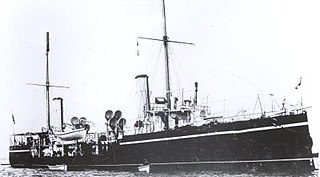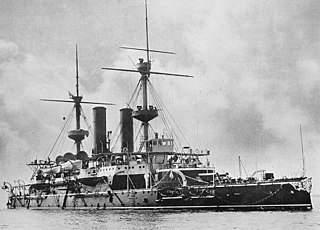
HMS Hood was a modified Royal Sovereign-class pre-dreadnought battleship built for the Royal Navy in the early 1890s. She differed from the other ships of the class in that she had cylindrical gun turrets instead of barbettes and a lower freeboard. She served most of her active career in the Mediterranean Sea, where her low freeboard was less of a disadvantage. The ship was placed in reserve in 1907 and later became the receiving ship at Queenstown, Ireland. Hood was used in the development of anti-torpedo bulges in 1913 and was scuttled in late 1914 to act as a blockship across the southern entrance of Portland Harbour after the start of World War I.

HMS Antelope was a Royal Navy Alarm-class torpedo gunboat. She was launched in 1893, reduced to harbour service from 1910 and was sold for scrapping in 1919.

HMS Camperdown was an Admiral-class battleship of the Royal Navy, named after Adam Duncan, 1st Viscount Duncan of Camperdown.

HMS Hawke, launched in 1891, was the seventh British warship to be named Hawke. She was an Edgar-class protected cruiser. In September 1911 the Hawke collided with the ocean liner RMS Olympic. The damage smashed the Hawke's bow and damaged the stern of the Olympic.

The third HMS Halcyon was a Dryad-class torpedo gunboat of the Royal Navy. Once described as "perhaps the smallest and least formidable vessel that ever crept into the 'Navy List'", she was launched in 1894 and was put up for sale before World War I. She was recommissioned in 1913, was converted to a minesweeper and served under the orders of the Admiral Commanding Coast Guard and Reserves. She was sold for breaking in 1919.

HMS Superb was an ironclad battleship designed by Sir Edward Reed for the Ottoman Navy, and was built in Britain by Thames Ironworks under the name of Hamidieh. She had both engines and sails.

HMS Rodney was a battleship of the Victorian Royal Navy, a member of the Admiral class of warships designed by Nathaniel Barnaby. The ship was the last British battleship to carry a figurehead although smaller ships continued to carry them.

HMS Revenge was one of seven Royal Sovereign-class pre-dreadnought battleships built for the Royal Navy during the 1890s. She spent much of her early career as a flagship for the Flying Squadron and in the Mediterranean, Home and Channel Fleets. Revenge was assigned to the International Squadron blockading Crete during the 1897–1898 revolt there against the Ottoman Empire. She was placed in reserve upon her return home in 1900, and was then briefly assigned as a coast guard ship before she joined the Home Fleet in 1902. The ship became a gunnery training ship in 1906 until she was paid off in 1913.
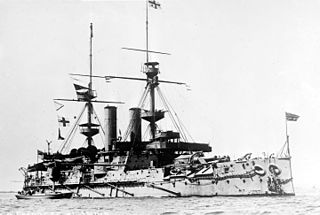
HMS Empress of India was one of seven Royal Sovereign-class pre-dreadnought battleships built for the Royal Navy during the 1890s. The ship was commissioned in 1893 and served as the flagship of the second-in-command of the Channel Fleet for two years. She was transferred to the Mediterranean Fleet in 1897, during which time Empress of India was assigned to the International Squadron blockading Crete during the uprising there. She returned home in 1901 and was briefly assigned as a coast guard ship in Ireland before she became the second flagship of the Home Fleet. The ship was reduced to reserve in 1905 and accidentally collided with the submarine HMS A10 the following year. Empress of India was taken out of service in early 1912 and accidentally struck a German sailing ship while under tow. She was sunk as a target ship in 1913.

HMS Barfleur was the second and last of the Centurion-class pre-dreadnought battleships built for the Royal Navy in the 1890s. Intended for service abroad, they exchanged heavy armour and a powerful armament for high speed and long range to counter the foreign armoured cruisers then being built as commerce raiders and were rated as second-class battleships.

HMS Ardent was a Royal Navy 27 knot torpedo boat destroyer ordered from John I Thornycroft & Company under the 1893 – 1894 Naval Estimates. She was the sixth ship to carry this name.
HMS Boxer was an Ardent-class destroyer which served with the Royal Navy, launched on 28 November 1894. She spent several years operating with the Mediterranean Fleet and remained active during the First World War. She was sunk in a collision on 8 February 1918.
HMS Hardy was a Hardy-class destroyer which served with the Royal Navy. She was built by William Doxford & Sons in 1895, launched on 16 December 1895, and sold off on 11 July 1911.
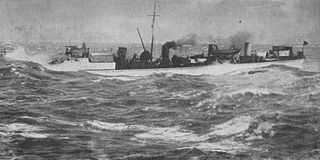
HMS Banshee was one of three Banshee-class destroyers which served with the Royal Navy.

HMS Dryad was the name ship of the Dryad-class torpedo gunboats. She was launched at Chatham Dockyard on 22 November 1893, the first of the class to be completed. She served as a minesweeper during World War I and was broken up in 1920.
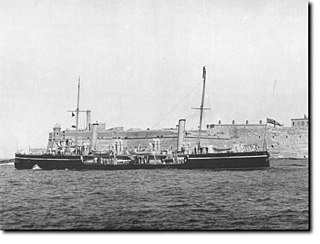
The sixth HMS Harrier was a Dryad-class torpedo gunboat. She was launched at Devonport Dockyard on 20 February 1894, and saw service in the Mediterranean and in fishery protection. She served as a minesweeper during World War I and was sold for commercial use in 1920.
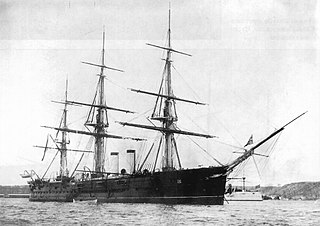
Gerzog Edinburgski was an armoured cruiser of the General-Admiral class built for the Imperial Russian Navy. She was the sister ship of General-Admiral and was named after Alfred, Duke of Saxe-Coburg and Gotha, Duke of Edinburgh who married Grand Duchess Maria Alexandrovna of Russia.
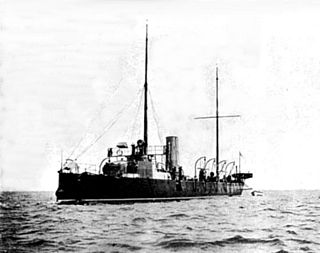
HMS Rattlesnake was a unique design of torpedo gunboat of the Royal Navy. A result of the Russian war scare of 1885, she was designed by Nathaniel Barnaby that year and built by Laird Brothers, of Birkenhead. Quickly made obsolete by the new torpedo boat destroyers, she became an experimental submarine target ship in 1906, and was sold in 1910.

HMS Isis was an Eclipse-class protected cruiser built for the Royal Navy in the mid-1890s.
















